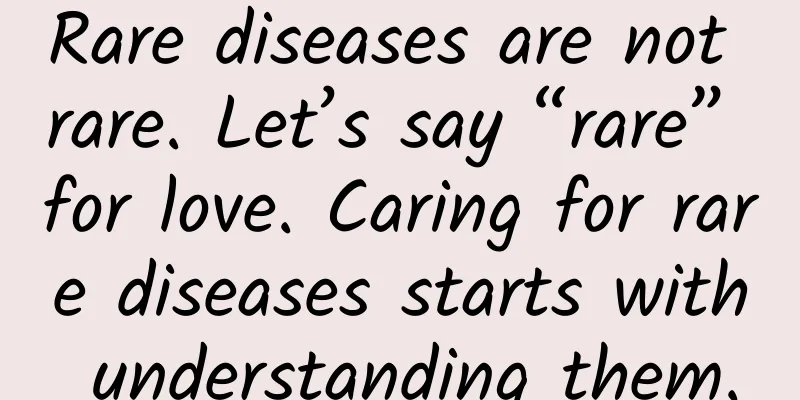Rare diseases are not rare. Let’s say “rare” for love. Caring for rare diseases starts with understanding them.

|
The book "The Code of Life" states that according to statistics, the average person is born with about 7 to 10 sets of defective genes and carries 2.8 pathogenic genes for recessive genetic diseases. In other words, each of us is a carrier of a rare disease gene, and as long as humans have life, there will be the possibility of developing rare diseases. 1. What is a rare disease? In my country, diseases with a neonatal incidence rate less than 1/10,000, a prevalence rate less than 1/10,000, and a number of patients less than 140,000 are called rare diseases. Even if the probability is one in ten thousand, it is 100% suffering for every rare disease patient and family. February 28, 2022 is the 15th "International Rare Disease Day". This year's theme is "Share the Color of Your Life". Porcelain Doll, Moon Child, and Butterfly Baby, these three fairy-tale names correspond to three rare diseases: osteogenesis imperfecta, albinism, and epidermolysis bullosa, which are also several "common" rare diseases. 2. The diagnosis of rare diseases is not the most difficult thing. The real difficulty lies in treatment. Among the more than 7,000 known rare diseases, less than 5% have effective treatments. Among the 121 diseases included in China's first batch of rare disease catalogs, only about 60% are "treatable with medicines." There is currently a gap in the treatment of most rare diseases. At present, more than 60 rare disease drugs have been approved for marketing in my country, and more than 40 have been included in the national medical insurance catalogue, involving 25 diseases. Spinal muscular atrophy (SMA), which became known to the public because of the "sky-high price" of 700,000 yuan per dose of medicine, is also one of the rare diseases. 3. Preventing rare diseases through three levels of prevention About 80% of rare diseases are caused by genetic defects, 50% occur at birth or in childhood, 30% of them do not survive beyond the age of 5, and 35% of newborns die from rare diseases. Early screening, early diagnosis, and early treatment, which has become a consensus in the field of cancer management, also applies to the diagnosis and treatment of rare diseases. How to prevent the occurrence of rare diseases through tertiary prevention? Primary prevention - pre-pregnancy. Strengthen premarital examinations, conduct eugenics genetic counseling before pregnancy, screen high-risk groups for genetic disease carriers, conduct comprehensive investigations, and prevent the disease from the source. If a couple has already given birth to a child with a rare disease, or has been confirmed through testing to carry a gene that causes a rare disease, they can use pre-implantation genetic testing (PGT, the third-generation IVF) to assist in reproduction, analyze the genetic material of the embryo, and select healthy embryos for implantation, in the hope of giving birth to a completely healthy child. Secondary prevention - prenatal. Prenatal examinations can screen out high-risk pregnant women, and timely prenatal diagnosis and screening can prevent the birth of children with rare congenital defects. Level 3 prevention - newborns. Some rare diseases, such as some genetic metabolic diseases and endocrine abnormalities, can be discovered in time through newborn disease screening, treated as early as possible, and the damage can be minimized. For example, comprehensive screening for phenylketonuria and congenital hypothyroidism should be carried out, follow-up, diagnosis, treatment and intervention of positive cases in newborn disease screening should be strengthened, and the treatment rate of confirmed cases should be improved. Rare diseases are not rare, they are around us, and everyone may have genetic defects. If a seemingly healthy couple happens to carry the same rare disease gene, they have a 25% chance of giving birth to a "rare" baby. Let the whole society pay attention to rare diseases and make rare diseases even rarer. |
<<: What are the benefits and functions of dried shrimp? How to make dried shrimp and seaweed soup
Recommend
What are the benefits and functions of buckwheat pillows? Is it normal for buckwheat pillows to have a smell?
Buckwheat pillows have the advantages of good air...
What to do if your breasts are lumpy and painful
Breasts are not only a reflection of women's ...
How to cure vaginitis?
Nowadays, women are often troubled by vaginitis. ...
My period has been postponed for five days.
The delayed menstruation should be taken seriousl...
How is Bacterial Vaginitis Caused?
There are many types of bacteria that can infect ...
Little girl's vagina is itchy
If a girl has vulvar itching, first of all, don&#...
The four things women are most satisfied with in bed
1. Praise for the body No matter how beautiful a ...
Whose fault is it that I feel itchy the next day after sex?
Sexual life is a matter between men and women, an...
Dietary considerations for multiple uterine fibroids
The disease of multiple uterine fibroids can caus...
Can I eat sesame cakes during menstruation?
Shaobing is a favorite choice of many people. Sha...
How can women quit smoking?
In our lives, smoking is no longer just a man'...
What medicine should I take for poor sleep during menopause?
Women who have poor sleep quality during menopaus...
What are the effects of cervical erosion?
In fact, many gynecological diseases are caused b...
What has the Qiantang River tide been called since ancient times? Is the Qiantang River fresh water or salt water?
There is a poem that goes: "When you look at...
What are the characteristics of uterine contractility?
If you ask me which factors may affect childbirth...









